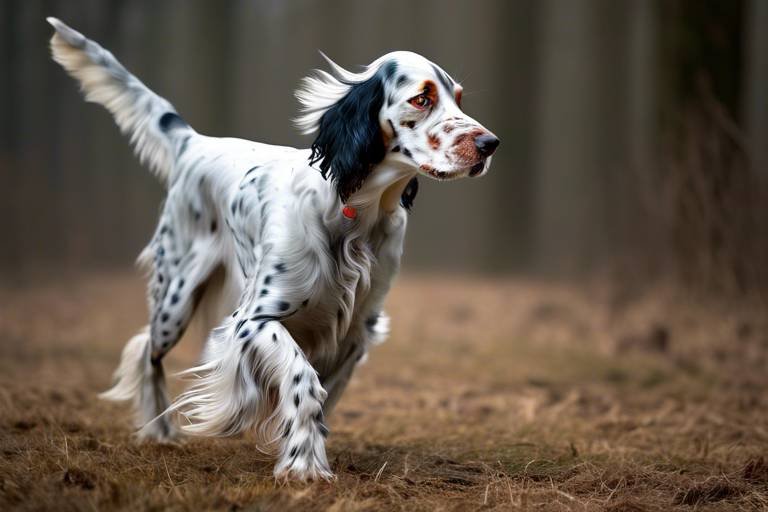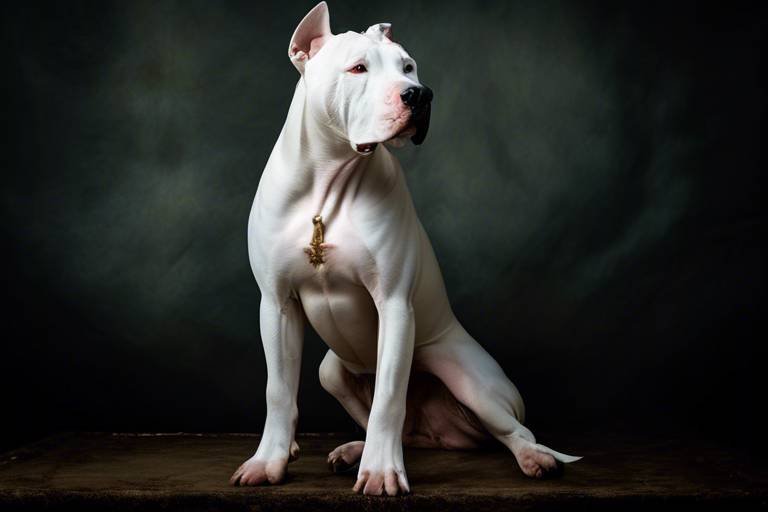The History and Characteristics of the Labrador Retriever
This article explores the origins, traits, and unique qualities of the Labrador Retriever, one of the most beloved dog breeds worldwide, known for its friendly demeanor and intelligence.
The Labrador Retriever has a rich history that dates back to the early 19th century. This breed originated from the St. John's dog, a breed of working dog used by fishermen in Newfoundland, Canada. These dogs were prized for their exceptional swimming abilities and were often used to retrieve fish that had escaped from nets. As the breed made its way to England, it caught the attention of noblemen who appreciated their intelligence and versatility.
In England, these dogs were refined and bred with other retrievers, leading to the development of the Labrador Retriever we know today. The breed was officially recognized by the American Kennel Club in 1917, and since then, they have become a staple in families and various working roles worldwide.
Labrador Retrievers are known for their distinctive physical traits. They typically weigh between 55 to 80 pounds and stand about 21.5 to 24.5 inches tall at the shoulder. Their short, dense coat is water-resistant, making them excellent swimmers. Labradors come in three primary colors: black, yellow, and chocolate. Each color has its own unique charm, but all share a friendly and approachable demeanor.
One of the most recognizable features of a Labrador is its otter-like tail, which helps them swim efficiently. Their expressive eyes and strong build contribute to their overall appeal, making them one of the most loved breeds around the globe.
Labradors are famous for their friendly and outgoing nature. They are known to be affectionate, loyal, and playful, making them excellent companions for families. Their sociability is one of their most endearing traits; they thrive on human interaction and often form strong bonds with their owners.
These dogs are also incredibly adaptable, fitting well into various lifestyles. Whether you're a busy professional or a stay-at-home parent, a Labrador can be a perfect addition to your family. Their gentle disposition makes them suitable for households with children and other pets.
Highly intelligent and eager to please, Labrador Retrievers excel in training. They are quick learners, which makes them ideal candidates for various roles, including service dogs, therapy dogs, and search-and-rescue dogs. Training a Labrador can be a rewarding experience, as they respond well to positive reinforcement techniques.
Here are some effective training techniques:
- Start with basic commands like "sit," "stay," and "come."
- Use treats and praise to encourage good behavior.
- Be consistent with commands and rules.
- Socialize your Labrador with other dogs and people.
With patience and dedication, you can harness their intelligence and energy, leading to a well-behaved companion.
Like all breeds, Labradors are prone to specific health issues. Common concerns include hip dysplasia, elbow dysplasia, and obesity. Regular check-ups with a veterinarian can help catch these issues early. It's crucial to maintain a healthy diet and ensure they get enough exercise to prevent weight gain.
Here are some preventative measures to keep your Labrador healthy:
- Regular veterinary check-ups.
- A balanced diet tailored to their age and activity level.
- Consistent exercise routines.
Labrador Retrievers are energetic dogs that require regular exercise. A daily routine of physical activity is essential to keep them healthy and happy. They enjoy activities such as swimming, fetching, and running. Engaging in these activities not only helps them burn off energy but also strengthens the bond between you and your furry friend.
Consider incorporating the following into their exercise routine:
- Daily walks of at least 30 minutes.
- Interactive playtime with toys.
- Swimming sessions during warmer months.
Proper grooming is essential for maintaining a Labrador's health and appearance. Their short coat requires minimal grooming, but regular brushing helps reduce shedding and keeps their skin healthy. Labradors tend to shed year-round, with heavier shedding occurring during seasonal changes.
Here are some grooming tips:
- Brush their coat at least once a week.
- Check their ears regularly for dirt and wax buildup.
- Trim their nails as needed.
Labradors serve various roles in society, from family pets to service dogs. Their versatility is remarkable; they can be trained for search and rescue, therapy work, and assistance for individuals with disabilities. Their friendly nature and intelligence make them ideal for these important roles, showcasing their significance in human lives.
Selecting the right Labrador Retriever involves considering various factors. It's crucial to choose a reputable breeder who prioritizes health and temperament. Understanding breed standards and ensuring a good match for your lifestyle will lead to a fulfilling companionship.
Here are some common questions about Labrador Retrievers:
- What is the lifespan of a Labrador Retriever? Typically, they live between 10 to 12 years.
- Do Labradors shed a lot? Yes, they do shed, but regular grooming can help manage it.
- Are Labradors good with children? Absolutely! They are known for their gentle and friendly nature.

Origins of the Labrador Retriever
The Labrador Retriever has a fascinating history that traces back to the early 19th century, primarily in Newfoundland, Canada. Initially, these dogs were known as St. John's dogs or Lesser Newfoundland, bred by local fishermen to assist in retrieving fish and other game from icy waters. Imagine a time when these loyal companions would leap into frigid waters, bringing back the day's catch while their human counterparts waited on the shore. This relationship between man and dog was not just practical; it was built on necessity and mutual respect.
As the breed evolved, they caught the attention of English nobility. In the early 1800s, wealthy sportsmen began importing these dogs to England, where they were further refined. The breed was crossed with other retrievers, which enhanced their retrieving abilities and temperament. This period marked the transition from a working dog to a beloved family pet, as their friendly nature and intelligence became evident. The name "Labrador" is believed to have originated from the Spanish word “labrador,” meaning "laborer," reflecting their hardworking roots.
Throughout the years, the Labrador Retriever has maintained its essential traits: a love for water, a strong work ethic, and an innate ability to bond with humans. Their role as hunting companions expanded, and they became known for their versatility in various fields, including search and rescue, therapy, and assistance for individuals with disabilities. The breed's adaptability to different environments and tasks has solidified its position as one of the most popular dog breeds worldwide.
Interestingly, the American Kennel Club recognized the Labrador Retriever as a distinct breed in 1917. Since then, they have consistently topped the charts as the most popular breed in the United States. The Labrador's charm lies not only in its rich history but also in its unwavering loyalty and friendly demeanor, making them a cherished addition to countless homes.
In summary, the origins of the Labrador Retriever are steeped in tradition and practicality. From their humble beginnings as fishing assistants to their current status as family companions and service dogs, Labradors have proven time and again that they are more than just pets; they are family members and invaluable partners in various aspects of life.

Physical Characteristics
The Labrador Retriever is one of the most recognizable dog breeds in the world, and it’s not just because of their friendly disposition. These dogs have a unique set of physical traits that make them both appealing and functional. Typically, a Labrador stands between 21.5 to 24.5 inches tall at the shoulder, with males generally being larger than females. Their weight usually ranges from 55 to 80 pounds, depending on their sex and overall health. But what truly sets them apart is their muscular build and strong, athletic appearance, which speaks to their origins as working dogs.
One of the most striking features of the Labrador is its short, dense coat. This coat serves a dual purpose: it provides insulation and repels water, making Labradors excellent swimmers. Labradors come in three primary colors: black, yellow, and chocolate. Each color has its own charm, but it’s the yellow variety that can range from a light cream to a deep gold, which is particularly eye-catching. The coat is also known for its shedding, especially during seasonal changes, making regular grooming essential for any Labrador owner.
Another distinctive characteristic of Labradors is their otter-like tail. This thick, tapering tail is not just for show; it acts as a rudder when they swim, helping them navigate through water with agility and grace. Their broad head, with a kind and intelligent expression, is complemented by their strong jaws and powerful neck, which are essential for retrieving game. The ears are medium-sized and hang close to their head, adding to their expressive demeanor.
In terms of overall appearance, Labradors exude a sense of strength and vitality. Their well-defined muscles and sturdy bones reflect their energetic nature and readiness for action. Whether they are playing fetch in the park or lounging at home, their physical characteristics contribute to their versatility as both a family pet and a working dog. The combination of their friendly looks and robust build makes Labradors a favorite among dog lovers everywhere.
To summarize the key physical traits of the Labrador Retriever, here’s a quick reference table:
| Characteristic | Description |
|---|---|
| Height | 21.5 to 24.5 inches |
| Weight | 55 to 80 pounds |
| Coat | Short, dense, water-resistant |
| Colors | Black, Yellow, Chocolate |
| Tail | Otter-like, thick, tapering |
In conclusion, the physical characteristics of the Labrador Retriever are not just aesthetically pleasing; they also play a vital role in the breed's functionality and adaptability. Whether you’re drawn to their friendly face, sturdy build, or playful nature, there’s no denying that Labradors are a breed that captures hearts and imaginations alike.

Temperament and Personality
The Labrador Retriever is often hailed as one of the most friendly and affectionate dog breeds around. Their temperament is a delightful blend of playfulness and loyalty, making them the ideal companions for families, singles, and everyone in between. Have you ever met a Labrador who didn't greet you with a wagging tail and an enthusiastic smile? It's almost like they have a built-in happiness meter!
One of the standout traits of Labradors is their sociability. They thrive on human interaction and are known for their friendly disposition towards both people and other animals. This innate friendliness is not just a personality quirk; it’s a genetic trait that has been honed over generations. Originally bred as fishing and hunting companions, their ability to get along with everyone has made them a favorite in households worldwide.
When it comes to loyalty, Labradors take the cake. They form strong bonds with their families and are always eager to be by your side. Imagine having a buddy who’s always ready for an adventure, whether it’s a hike in the woods or a cozy evening on the couch. Their loyalty extends beyond just companionship; Labradors are also known for their protective instincts, making them great family dogs. They are not typically aggressive, but their presence can be a deterrent to unwanted visitors.
Another fascinating aspect of their personality is their intelligence. Labradors are quick learners and often excel in obedience training. Their eagerness to please makes training sessions feel less like chores and more like fun activities. They have a knack for picking up commands and tricks, which is why they frequently serve as service animals or in roles like search and rescue. It’s like they have a sixth sense for understanding what their humans want!
However, it’s important to note that their friendly and playful nature requires proper guidance. Without sufficient training and socialization, a Labrador’s exuberance can lead to overzealous behavior. Think of them as a big, lovable teddy bear—wonderful to have around but requiring some boundaries to ensure they don’t accidentally knock over Grandma during a play session!
In conclusion, the Labrador Retriever is a breed that embodies joy, loyalty, and intelligence. Their innate friendliness makes them wonderful companions, while their intelligence and eagerness to please make them highly trainable. Whether you’re looking for a family pet, a loyal friend, or a working partner, Labradors check all the boxes. They truly are a breed that brings happiness wherever they go!
- Are Labradors good with children? Yes, Labradors are known for their gentle and playful nature, making them excellent companions for children.
- Do Labradors require a lot of exercise? Absolutely! Labradors are energetic dogs that need regular exercise to stay healthy and happy.
- Are Labradors easy to train? Yes, their intelligence and eagerness to please make them one of the easiest breeds to train.
- How often should I groom my Labrador? Labradors shed moderately, so regular brushing is recommended, especially during shedding seasons.

Training and Intelligence
The Labrador Retriever is not just a pretty face; it’s a brainy breed that is often hailed as one of the most intelligent dogs out there. This intelligence, combined with their eagerness to please, makes Labradors a joy to train. Have you ever tried teaching a dog a new trick? With a Labrador, it often feels like they’re just waiting for you to give them the cue. Their ability to learn commands quickly is nothing short of impressive, and they thrive on positive reinforcement.
When it comes to training, consistency is key. Labradors respond exceptionally well to structured training sessions, which should ideally be short but frequent. Imagine trying to learn a new skill; wouldn’t you prefer a series of engaging, bite-sized lessons rather than one long, monotonous lecture? The same goes for your furry friend! Incorporating fun elements into training can keep your Labrador engaged and excited. For instance, using their favorite toys as rewards can turn a simple command into a thrilling game.
Here are a few effective training techniques that can help you harness your Labrador's intelligence:
- Positive Reinforcement: Rewarding good behavior with treats, praise, or playtime encourages your Labrador to repeat those behaviors.
- Socialization: Exposing your Labrador to different environments, people, and other animals helps them become well-rounded and confident.
- Consistency: Using the same commands and cues ensures that your Labrador understands what you expect from them.
Additionally, Labradors excel in various roles, including therapy dogs, search and rescue, and assistance for people with disabilities. Their intelligence allows them to learn complex tasks and adapt to different situations. For instance, a Labrador trained as a service dog can recognize signs of distress in their owner and respond appropriately, whether it’s fetching help or providing comfort. This versatility is a testament to their remarkable cognitive abilities.
However, it’s essential to remember that with great intelligence comes the potential for mischief. A bored Labrador can easily turn into a little troublemaker, so keeping their minds stimulated is crucial. Puzzle toys, obedience training, and agility courses can provide both mental and physical challenges. Think of it as giving your Labrador a workout for their brain—just like humans, dogs need mental exercise to stay happy and healthy.
In conclusion, training a Labrador Retriever is an enriching experience that strengthens the bond between you and your dog. Their intelligence, combined with their friendly disposition, makes them not only easy to train but also incredibly rewarding companions. So, whether you’re teaching them to fetch a ball or assisting them in learning vital service tasks, you’re not just training a dog; you’re nurturing a lifelong friendship filled with joy and adventure.
Here are some common questions about training and intelligence in Labrador Retrievers:
- How long does it take to train a Labrador? Training duration varies, but with consistency, most Labradors can master basic commands within a few weeks.
- Are Labradors easy to train? Yes, Labradors are generally eager to please and respond well to positive reinforcement methods.
- What age should I start training my Labrador? You can start training your Labrador as early as 8 weeks old, focusing on basic commands and socialization.

Health Considerations
The health of your Labrador Retriever is paramount to ensuring a long, happy life for your furry friend. Like all breeds, Labradors are susceptible to certain health issues that can affect their quality of life. Understanding these potential problems is the first step in being a responsible pet owner. The most common health concerns include obesity, hip dysplasia, elbow dysplasia, and certain genetic conditions.
One of the most significant issues facing Labradors is obesity. These dogs love food, and their eagerness to please can lead them to overeat. It's essential to monitor their diet closely, providing them with a balanced nutrition plan that is appropriate for their age, size, and activity level. Regular vet check-ups can help keep their weight in check and ensure they remain healthy. A simple table below outlines the ideal weight ranges for Labradors based on their gender:
| Gender | Ideal Weight Range |
|---|---|
| Male | 65-80 lbs (29-36 kg) |
| Female | 55-70 lbs (25-32 kg) |
Another concern is hip and elbow dysplasia, which are genetic conditions that can lead to arthritis and pain in older age. Regular exercise and a healthy diet can help mitigate some of these risks, but it’s crucial to consult with your veterinarian for screening options, especially if you're considering breeding your Labrador.
Additionally, Labradors can be prone to other genetic disorders such as progressive retinal atrophy (PRA) and exercise-induced collapse (EIC). PRA can lead to vision problems, while EIC can cause sudden weakness during intense exercise. Genetic testing is available and can help identify these issues before they become problematic.
Preventative care is vital for maintaining your Labrador's health. Regular vaccinations, flea and tick prevention, and annual health screenings play a crucial role in early detection and management of potential health issues. Keeping a close eye on their behavior and physical condition can also alert you to any changes that may require veterinary attention.
In summary, while Labrador Retrievers are generally healthy dogs, being proactive about their health can make a world of difference. By understanding common health issues and implementing preventative measures, you can help ensure your Labrador lives a long, vibrant life full of tail wags and joyous moments.
- What are the signs of obesity in Labradors? Look for excessive weight gain, difficulty in movement, and a lack of energy. A veterinarian can provide the best guidance on maintaining a healthy weight.
- How often should I take my Labrador to the vet? Regular check-ups are recommended at least once a year, but more often if your dog is older or has health concerns.
- Can I prevent hip dysplasia in my Labrador? While you cannot prevent it entirely, maintaining a healthy weight, providing proper nutrition, and regular exercise can help reduce the risk.

Exercise Needs
Labrador Retrievers are not just your average couch potatoes; they are energetic and playful companions that thrive on regular exercise. Imagine a ball of energy, always ready to chase after a frisbee or dive into a lake! It’s no wonder that these dogs require a significant amount of physical activity to keep them happy and healthy. A well-exercised Labrador is a happy Labrador, and that’s a fact!
So, what does a typical exercise routine look like for a Labrador? Ideally, they need at least one hour of exercise every day. This can include a variety of activities such as walking, running, swimming, or playing fetch. Not only does this help them burn off excess energy, but it also strengthens their muscles and promotes overall well-being. Think of it as a daily workout that keeps them fit and ready for their next adventure!
To keep things interesting, you can mix up their exercise routine. For instance, you might start with a brisk walk in the morning, followed by some playtime in the backyard, and then a swim in the afternoon. Here’s a quick breakdown of some great exercise options for your Labrador:
- Walking: A simple yet effective way to get your dog moving. Aim for at least 30 minutes.
- Running: If you’re a runner, take your Labrador along! They make excellent running partners.
- Swimming: Labradors are natural swimmers. Take them to a dog-friendly beach or pool.
- Fetch: A classic game that never gets old. Use a ball or frisbee to keep them engaged.
Moreover, mental stimulation is just as crucial as physical exercise. Labradors are intelligent dogs, and without proper mental challenges, they can become bored and develop destructive behaviors. Incorporating puzzle toys, obedience training, or even agility courses can keep their minds sharp. Think of it as a workout for their brain!
Lastly, always pay attention to your Labrador's cues. They’ll let you know when they’re tired or need a break. Over-exercising can lead to injuries, especially in younger dogs whose bodies are still developing. Always consult with your veterinarian to tailor an exercise plan that suits your dog's age, health, and energy level.
1. How much exercise does a Labrador Retriever need daily?
Most Labradors require at least one hour of exercise each day to stay healthy and happy.
2. Can Labradors swim?
Yes! Labradors are natural swimmers and often enjoy water activities. Swimming is a great way for them to exercise.
3. What are some signs my Labrador is tired?
Signs of fatigue in Labradors include slowing down, lagging behind during walks, or lying down and refusing to get up.
4. How can I mentally stimulate my Labrador?
You can use puzzle toys, engage in obedience training, or set up agility courses to keep your Labrador mentally challenged.

Grooming and Care
Grooming your Labrador Retriever is not just about keeping them looking good; it's also a vital part of their overall health and well-being. With their short, dense coat, Labradors are relatively low-maintenance compared to some other breeds, but they still require regular care to ensure they remain happy and healthy. One of the most important aspects of grooming is shedding. Labradors shed year-round, but they experience heavier shedding during the spring and fall. To keep your home fur-free and your dog comfortable, regular brushing is essential. A good-quality slicker brush or a de-shedding tool can work wonders in managing their coat.
In addition to brushing, bath time is another important aspect of grooming. While you don’t need to bathe your Labrador too frequently—every couple of months is usually sufficient—it's crucial to use a dog-specific shampoo to avoid irritating their skin. Be sure to rinse thoroughly to remove all soap residue, as this can lead to skin issues if left behind. Always remember that Labradors love water, so bath time can also be a fun bonding experience!
Furthermore, regular ear cleaning is essential for Labradors. Their floppy ears can trap moisture and debris, making them prone to infections. Check their ears weekly for dirt or wax buildup, and clean them gently with a veterinarian-recommended ear cleaner. It's also wise to keep an eye on their nails; regular trimming is necessary to prevent overgrowth and discomfort. Ideally, you should trim their nails every 3-4 weeks, but the frequency can vary based on their activity level and the surfaces they walk on.
Lastly, don’t forget about dental care. Just like humans, dogs can suffer from dental issues if their teeth aren’t properly cared for. Regular brushing of your Labrador's teeth can help prevent plaque buildup and keep their breath fresh. Aim for brushing their teeth several times a week, and consider providing dental chews or toys that promote oral health.
In summary, grooming your Labrador Retriever involves a combination of brushing, bathing, ear cleaning, nail trimming, and dental care. By establishing a consistent grooming routine, you can ensure your furry friend remains healthy, happy, and looking their best!
- How often should I brush my Labrador? It's recommended to brush your Labrador at least once a week, but during shedding seasons, you may need to brush them several times a week.
- Can I use human shampoo on my dog? No, it's best to use a dog-specific shampoo to avoid skin irritation.
- How can I tell if my dog's ears are dirty? If you notice a foul smell, redness, or excessive scratching, it may be time to clean your dog's ears.
- How do I know if my Labrador's nails need trimming? If you can hear their nails clicking on the floor or if they seem to be getting caught on surfaces, it's time for a trim.

Role in Society
Labrador Retrievers are not just adorable companions; they play a vital role in our society, showcasing their versatility and adaptability in various settings. From being cherished family pets to serving as service dogs and working alongside professionals, Labradors have earned their place in the hearts of many. Their friendly demeanor and intelligence make them ideal candidates for numerous roles.
One of the most notable contributions of Labradors is their work in the medical field. They are often trained as therapy dogs, providing comfort and support to patients in hospitals and nursing homes. Imagine a child in a hospital room, feeling scared and alone. A gentle Labrador enters, tail wagging, bringing a sense of warmth and joy. These dogs have the remarkable ability to lift spirits and promote healing through their loving nature.
In addition to therapy work, Labradors are also employed as service dogs for individuals with disabilities. They assist those who are visually impaired, helping them navigate the world safely. Their keen sense of smell and ability to detect changes in their owner’s condition make them invaluable in situations where health monitoring is crucial. For example, Labradors can be trained to alert their owners to low blood sugar levels or impending seizures, acting as a lifeline in critical moments.
Moreover, Labradors are frequently used in search and rescue operations. Their natural instincts and strong sense of smell enable them to locate missing persons in various environments, whether in the wilderness or urban settings. Picture a team of dedicated rescuers, combing through debris after a disaster, with a Labrador leading the charge, sniffing out survivors. Their contributions can mean the difference between life and death.
Beyond these impressive roles, Labradors also excel in law enforcement and military work. They are trained to detect drugs, explosives, and even track down suspects. Their friendly appearance often disarms people, making them effective in community policing efforts. The combination of their intelligence and sociable nature allows them to build trust with the public while performing critical duties.
In a more casual context, Labradors are also popular as therapy animals in schools and workplaces. They help reduce stress and anxiety, enhancing overall well-being. Many offices have embraced the idea of having a Labrador on-site to promote a positive work environment. Just imagine taking a break from a hectic day to pet a fluffy Labrador – it’s a simple yet profound way to boost morale and productivity!
In summary, the role of Labrador Retrievers in society extends far beyond being family pets. Their contributions as service dogs, therapy animals, search and rescue partners, and law enforcement aids underline their importance in various fields. As we continue to recognize and appreciate their capabilities, it's clear that Labradors are more than just dogs; they are true companions and heroes in our everyday lives.
- What makes Labradors good service dogs? Their intelligence, eagerness to please, and friendly nature make them excellent service dogs.
- Can Labradors be trained for search and rescue? Yes, Labradors are often trained for search and rescue due to their strong sense of smell and stamina.
- How do Labradors help in therapy? They provide emotional support and companionship, helping reduce anxiety and promote healing.
- Are Labradors suitable for families? Absolutely! Their friendly and loyal nature makes them great family pets.

Choosing the Right Labrador
When it comes to choosing the right Labrador Retriever, there are several important factors to consider that can significantly impact your experience as a dog owner. First and foremost, think about your lifestyle. Are you an active individual who enjoys outdoor activities, or do you prefer a more laid-back lifestyle? Labradors thrive in environments where they can engage in physical activities, so if you're someone who loves hiking, running, or playing fetch, a Labrador might be the perfect companion for you.
Next, consider your living situation. Do you have a spacious backyard where your Labrador can romp around, or do you live in a smaller apartment? While Labradors can adapt to various living conditions, they do need ample space to move around and play. If you live in an apartment, be prepared to take your dog on frequent walks and provide plenty of opportunities for exercise and playtime.
Another crucial aspect to consider is whether you want a puppy or an adult dog. Puppies are undeniably adorable, but they come with their own set of challenges, including house training and the need for socialization. On the other hand, adopting an adult Labrador can provide you with a dog that already has established behaviors and may even be trained. Think about what fits your needs and capabilities better.
When selecting a Labrador, it’s essential to find a reputable breeder or rescue organization. A good breeder will ensure that their puppies are healthy and well-socialized, while a rescue organization can connect you with dogs in need of a loving home. Don’t hesitate to ask questions about the dog’s health history, temperament, and any specific needs they may have. Here are some tips for finding a reputable source:
- Research breeders: Look for breeders who are members of recognized breed clubs and who follow ethical breeding practices.
- Visit in person: If possible, visit the breeder’s facility to see the living conditions of the puppies and their parents.
- Ask for health clearances: Ensure that the breeder provides health clearances for common Labrador health issues.
Additionally, consider the dog’s temperament and personality traits. Some Labradors may be more energetic and playful, while others may have a calmer demeanor. Spend time with the dog before making a decision to see if their personality aligns with your own. If you have children or other pets, it’s also wise to assess how the Labrador interacts with them to ensure a harmonious household.
Finally, think about your long-term commitment. Owning a dog is a significant responsibility that lasts for many years. Make sure you’re ready to provide the time, attention, and resources necessary for a Labrador’s care. They require regular exercise, mental stimulation, and social interaction to thrive. If you’re ready to welcome a Labrador into your life, you’ll find a loyal and loving companion who will bring joy and adventure to your everyday routine.
Q: How do I know if a Labrador is the right breed for me?
A: Consider your activity level, living situation, and whether you can commit to the dog's exercise and socialization needs. Labradors are active and friendly, making them great for families and active individuals.
Q: What should I look for in a reputable breeder?
A: Look for breeders who prioritize health testing, provide health clearances, and allow you to visit their facilities. They should be knowledgeable about the breed and willing to answer your questions.
Q: Should I adopt a puppy or an adult Labrador?
A: It depends on your preference and lifestyle. Puppies require more training and socialization, while adult dogs may already have established behaviors. Consider what fits your situation best.
Frequently Asked Questions
- What is the origin of the Labrador Retriever?
The Labrador Retriever originated in the early 19th century in Newfoundland, Canada. Initially, they were bred to assist fishermen by retrieving fish and helping with nets. Their friendly nature and intelligence made them popular companions, eventually leading to their recognition as a distinct breed.
- What are the physical characteristics of a Labrador Retriever?
Labrador Retrievers are medium to large-sized dogs, typically weighing between 55 to 80 pounds. They have a short, dense coat that comes in three primary colors: black, yellow, and chocolate. Their strong build, broad head, and expressive eyes make them easily recognizable and adored by many.
- How would you describe a Labrador's temperament?
Labradors are known for their friendly and outgoing personalities. They are incredibly sociable, loyal, and great with children, making them ideal family pets. Their playful nature and eagerness to please also make them excellent service dogs.
- Are Labrador Retrievers easy to train?
Absolutely! Labradors are highly intelligent and eager to learn, which makes them one of the easiest breeds to train. They respond well to positive reinforcement techniques and enjoy engaging in various activities that challenge their minds.
- What health issues are common in Labradors?
Labrador Retrievers can be prone to certain health issues, including hip and elbow dysplasia, obesity, and progressive retinal atrophy. Regular check-ups with a veterinarian and a balanced diet can help mitigate these risks and keep your Labrador healthy.
- How much exercise does a Labrador need?
Labradors are energetic dogs that require at least 1 hour of exercise daily. Regular walks, playtime, and mental stimulation are essential to keep them happy and prevent boredom-related behaviors.
- What grooming needs do Labradors have?
While Labradors have a short coat, they do shed, especially during seasonal changes. Regular brushing, at least once a week, can help manage shedding and keep their coat healthy. Additionally, routine nail trimming and ear cleaning are important aspects of their grooming routine.
- What roles do Labradors play in society?
Labrador Retrievers serve various roles, including family pets, therapy dogs, guide dogs for the visually impaired, and search-and-rescue dogs. Their versatility and friendly demeanor make them valuable companions in many fields.
- How do I choose the right Labrador Retriever?
When selecting a Labrador, consider factors such as the breeder's reputation, the puppy's temperament, and your lifestyle. It's essential to choose a breeder who prioritizes health testing and socialization to ensure a well-adjusted dog.



















